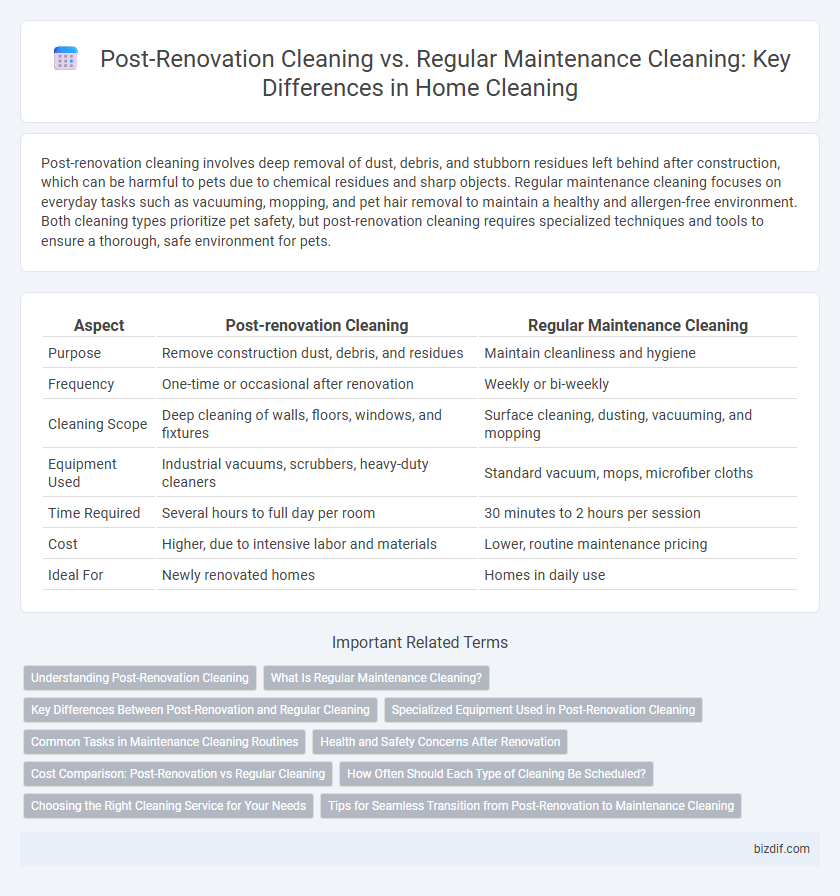Post-renovation cleaning involves deep removal of dust, debris, and stubborn residues left behind after construction, which can be harmful to pets due to chemical residues and sharp objects. Regular maintenance cleaning focuses on everyday tasks such as vacuuming, mopping, and pet hair removal to maintain a healthy and allergen-free environment. Both cleaning types prioritize pet safety, but post-renovation cleaning requires specialized techniques and tools to ensure a thorough, safe environment for pets.
Table of Comparison
| Aspect | Post-renovation Cleaning | Regular Maintenance Cleaning |
|---|---|---|
| Purpose | Remove construction dust, debris, and residues | Maintain cleanliness and hygiene |
| Frequency | One-time or occasional after renovation | Weekly or bi-weekly |
| Cleaning Scope | Deep cleaning of walls, floors, windows, and fixtures | Surface cleaning, dusting, vacuuming, and mopping |
| Equipment Used | Industrial vacuums, scrubbers, heavy-duty cleaners | Standard vacuum, mops, microfiber cloths |
| Time Required | Several hours to full day per room | 30 minutes to 2 hours per session |
| Cost | Higher, due to intensive labor and materials | Lower, routine maintenance pricing |
| Ideal For | Newly renovated homes | Homes in daily use |
Understanding Post-Renovation Cleaning
Post-renovation cleaning targets deep debris removal, including dust, paint splatters, and construction residues that regular maintenance cleaning cannot eliminate. It involves specialized tools and techniques to restore surfaces, fixtures, and air quality affected by renovation work. Understanding post-renovation cleaning emphasizes its necessity in preparing a safe, spotless living environment after remodeling projects.
What Is Regular Maintenance Cleaning?
Regular maintenance cleaning involves routine tasks such as dusting, vacuuming, mopping floors, and sanitizing surfaces to keep a home consistently clean and organized. This type of cleaning targets daily dirt, dust, and allergens, ensuring a healthy living environment over time. Unlike post-renovation cleaning, it does not address heavy debris or construction residues but emphasizes upkeep and prevention of buildup.
Key Differences Between Post-Renovation and Regular Cleaning
Post-renovation cleaning involves removing construction dust, debris, and paint splatters, requiring heavy-duty tools and specialized cleaning agents to restore the home's surfaces to a pristine condition. Regular maintenance cleaning focuses on routine tasks such as dusting, vacuuming, and sanitizing commonly used areas to maintain overall cleanliness and hygiene. The primary difference lies in the intensity and scope, with post-renovation cleaning addressing deep, structural contaminants while regular cleaning manages everyday dirt and clutter.
Specialized Equipment Used in Post-Renovation Cleaning
Post-renovation cleaning requires specialized equipment such as heavy-duty vacuums with HEPA filters to efficiently remove fine dust and debris left after construction work. Industrial steam cleaners and power scrubbers are also essential for tackling hardened residue and paint splatters that regular maintenance cleaning tools cannot handle. These advanced tools ensure thorough sanitation and restoration of the home environment following renovations.
Common Tasks in Maintenance Cleaning Routines
Maintenance cleaning routines typically include dusting surfaces, vacuuming carpets, mopping floors, and wiping down kitchen countertops to prevent buildup of dirt and grime. Regular tasks also involve disinfecting high-touch areas such as doorknobs, light switches, and bathroom fixtures to reduce the spread of germs. These consistent efforts help maintain a clean and healthy living environment between more intensive post-renovation cleanings.
Health and Safety Concerns After Renovation
Post-renovation cleaning addresses hazardous dust, chemical residues, and debris that pose respiratory and allergy risks, unlike regular maintenance cleaning that targets everyday dirt and stains. Specialized techniques and equipment, such as HEPA vacuums and industrial-strength cleaners, are necessary to remove fine dust particles and toxic substances left behind by construction materials. Ensuring a thorough post-renovation clean is critical for restoring indoor air quality and preventing health issues like asthma attacks or skin irritation in occupants.
Cost Comparison: Post-Renovation vs Regular Cleaning
Post-renovation cleaning typically incurs higher costs due to extensive debris removal, deep dust extraction, and surface polishing compared to regular maintenance cleaning, which involves routine dusting, vacuuming, and light sanitizing. The average price for post-renovation cleaning ranges between $300 and $800, depending on the size of the property and extent of renovation, while regular maintenance cleaning usually costs $100 to $250 per visit. Investing in regular cleaning helps maintain cleanliness and can reduce the frequency and expense of costly post-renovation cleanups.
How Often Should Each Type of Cleaning Be Scheduled?
Post-renovation cleaning should be scheduled immediately after construction or remodeling projects to remove dust, debris, and construction residue, typically as a one-time deep clean. Regular maintenance cleaning is recommended weekly or biweekly to maintain cleanliness, prevent dust buildup, and keep living spaces sanitary. The frequency of each cleaning type depends on factors such as the size of the home, renovation scope, and household activity levels.
Choosing the Right Cleaning Service for Your Needs
Post-renovation cleaning involves deep cleaning to remove construction dust, debris, and residues, targeting surfaces like walls, floors, and fixtures, while regular maintenance cleaning focuses on routine tasks such as dusting, vacuuming, and sanitizing to keep your home consistently tidy. Selecting the right cleaning service depends on the scope of cleaning required, with specialized post-renovation teams equipped for intensive cleaning and regular cleaners optimized for ongoing upkeep. Understanding the difference ensures effective resource allocation and satisfaction with the cleanliness level tailored to your home's condition.
Tips for Seamless Transition from Post-Renovation to Maintenance Cleaning
Post-renovation cleaning requires thorough removal of dust, debris, and construction residues using heavy-duty vacuums and specialized cleaning solutions, while regular maintenance cleaning focuses on routine dusting, mopping, and surface disinfection. To ensure a seamless transition, prioritize deep cleaning of HVAC systems, air vents, and hard-to-reach areas to prevent lingering dust during maintenance phases. Scheduling consistent cleaning intervals and using high-efficiency particulate air (HEPA) filters can maintain indoor air quality and extend the lifespan of cleaned surfaces.
Post-renovation cleaning vs Regular maintenance cleaning Infographic

 bizdif.com
bizdif.com